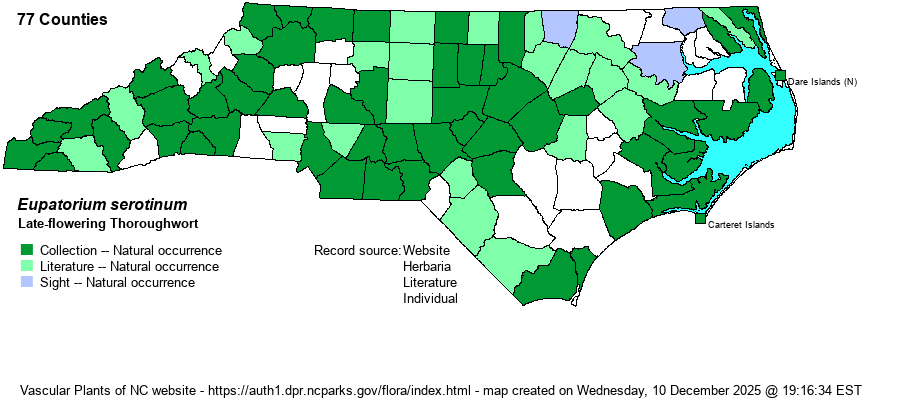| Author | Michaux | |
| Distribution | More-or-less throughout the state, but with gaps in the Mountains, upper Piedmont, Sandhills, and middle Coastal Plain. Weakley (2024) suggests that this species' original range was near-coastal and maritime, but has moved inland with disturbance. However, the wide distribution across the eastern U.S. argues against this, as does the paucity of specimens from the Outer Banks and the odd gap (real?) in the central Coastal Plain.
Southeastern NY to MN and NE, south to FL and TX; Mex. Adventive in MA and Ont. | |
| Abundance | Clearly increasing in the state in recent decades, with many new county records. Common to very common in the eastern and central Piedmont, and in the lower Coastal Plain. Infrequent in the Mountains and western Piedmont, as well as in much of the inner Coastal Plain. It has clearly been under-collected in the state, at least since 2000, considering its increasingly common and widespread nature. | |
| Habitat | Bottomland forests, moist slopes above creeks and small rivers, interdune swales, margins of brackish marshes, damp meadows, roadsides, powerlines, clearings. This species has weedy tendencies, often vigorously growing in recently disturbed moist soil such as in sewerline clearings and floodplain openings. |
| Phenology | Flowering and fruiting late August-October. | |
| Identification | This tall Eupatorium regularly reaches 4-5, even 6 feet tall. Leaves are opposite and distinctly stalked (stalks often 1 inch or longer), lanceolate with a sharp, tapered tip, and sharply toothed on margins. The base is distinctly entire, rounded to at times rather squared-off. It should not be confused with any other species owing to the long petioles and entire leaf bases. | |
| Taxonomic Comments | None
| |
| Other Common Name(s) | Late Eupatorium, Late Boneset, Late Thoroughwort | |
| State Rank | S5 | |
| Global Rank | G5 | |
| State Status | | |
| US Status | | |
| USACE-agcp | FAC link |
| USACE-emp | FAC link |

